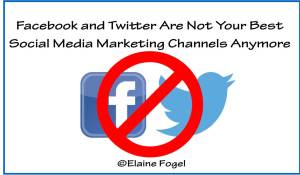prospects
I’ll  bet your small business or nonprofit organization spends considerable time on its Facebook page and Twitter account trying to engage new people. After all, aren’t these two social media sites the most effective in reaching prospects, customers, and donors?
bet your small business or nonprofit organization spends considerable time on its Facebook page and Twitter account trying to engage new people. After all, aren’t these two social media sites the most effective in reaching prospects, customers, and donors?
Not anymore says a recent Forrester study. “It’s clear that Facebook and Twitter don’t offer the relationships that marketing leaders crave. Yet most brands still use these sites as the centerpiece of their social efforts — thereby wasting significant financial, technological, and human resources on social networks that don’t deliver value,” says Nate Elliott of Forrester.
Now get this… “In the next 18 months… Facebook will become nothing but a repository for display ads,” Elliott predicts. Holy!!
So now what? Continue reading
Guest post by Lynsey Bowen
 If we get down to what marketing is about, it’s basically real estate. Think of the human brain as having some areas on it labelled, “This space for rent.” You don’t buy that space with a mortgage, though. Rather, you buy that space with an idea.
If we get down to what marketing is about, it’s basically real estate. Think of the human brain as having some areas on it labelled, “This space for rent.” You don’t buy that space with a mortgage, though. Rather, you buy that space with an idea.
If you’re unfamiliar with the term, “ideavirus,” it’s an idea that spreads like a virus. A good idea doesn’t cut it. Putting engine cleaner in your tank is a good idea, but how many people do it? Eating healthy is a good idea, but last we checked, there are more McDonald’s in the U.S. than there are vegetarian restaurants.
With a big marketing budget, you can buy a lot of ad space and hire brilliant creatives whose names alone will boost your brand, even if their ads are lousy. But, when it comes to developing an idea that has sharability built right into it, you and McDonald’s are beginning at the same starting line.
Now, implementing those ideas, on the other hand… well, on that level, you’ve got to be very creative to make up for a lack of money. Luckily, you do have some options. Here are some ideas:
Be an Aggressive Stat-Checker
Develop a zero tolerance policy for ads that just aren’t working. To a certain extent, this may feel like the efficiency-driven manic number crunching that dominates corporate culture, but you can think about changing how people do business when you make your second million.
Become a Big Fish in a Small Pond
Downsize what you do. Expand into a niche, not beyond it, and you’ll be able to focus on a much more concentrated percentage of the population - people who are already interested in what you’re selling. Pre-qualify your prospects and don’t waste time and money advertising to people who are outside your area of interest.
Make DIY Part of Your Brand
So you can’t afford professional talent. One option is to buy cheap, corny-looking stock photos and pay someone in another country a buck an hour to produce something that will look like your big-money competitors, only not as good. Or, you can do it yourself and allow the handmade feel to be a part of your brand.
Note: this works better for some businesses than others. iPhone-snapped photos might feel quaint and fun for a catalog selling hand-knit sweaters and hats, but they might not inspire confidence at a law firm.
Don’t Overextend
When you overextend, when you buy more ad space than you can afford, you wind up with late fees and fines that devour your ad budget. Buy less than you can afford, and you’ll always be able to pay your vendors on time.
Hashtaggin
Hashtags have gotten a bad name lately, as they’re a way for lazy people to pretend to campaign for social change. For an advertiser though, they’re golden. Rewarding your customers with discounts, freebies and special offers when they hashtag your brand is a great way to get them to spread the word. You can ask for customer referrals, but people are more likely to help out if they feel there’s something in it for them.
A common mistake when it comes to marketing: entrepreneurs, freelancers, and small business owners often think “If only I had the right exposure, I could really blow up.” Exposure isn’t the only thing standing between you and greater success. Before you can take that “for rent” sign down from prospects’ minds, you need something that they will respond to, something that they will gladly allot that space to.
In short, more exposure can be a big help, but before you start worrying about your marketing budget, consider whether or not that exposure will help.
——————————————————————————————————————————————————
 Lynsey Bowen works as a branding and marketing consultant for connectmyapps.com. She has a keen interest in Internet marketing, SEO, web design, and graphic design.
Lynsey Bowen works as a branding and marketing consultant for connectmyapps.com. She has a keen interest in Internet marketing, SEO, web design, and graphic design.
 If your company’s target market segments include other businesses, how are you treating them online? Do you view their buyers differently because they represent organizations, or do you treat them like individuals?
If your company’s target market segments include other businesses, how are you treating them online? Do you view their buyers differently because they represent organizations, or do you treat them like individuals?
If you approach B2B online marketing the same way you would if customers and prospects were consumers, you’re ahead of the game. According to a recent study by Forrester Consulting for Intershop, and reported by eMarketer, “Business-to-business (B2B) end-user buyers—nonprocurement business professionals who purchase products and services for work-related activities… want a consumer like experience when researching and making business purchases online.”



